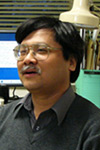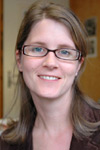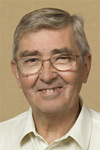 |
|
|
 |
Dark Matter Determines the Universe

Yasuhiro Okada, KEK |
You may see thousands of stars or countless numbers of galaxies in the night sky. The universe is so vast that it would seem like just an infinite number of galaxies are out there. But in fact, what a human observes in the universe as visible light or any other form of radiation is just a fraction of what actually exists.
Astronomers have been observing the motions of the celestial objects such as stars in a galaxy, galaxies in a cluster, and clusters in the larger structure for several decades. Scientists concluded that there is something in the universe which affects the gravitational motions of the objects, which is not visible in the observations. They named this mysterious mass "dark matter". By using the world's biggest accelerators, physicists think they may be able to now answer questions about dark matter and how exactly it affected the fate of the universe.
Yasuhiro Okada, KEK, summarized the recent developments of the theoretical and phenomenological studies at the Linear Collider Workshop 2006 (LCWS06). "In recent years it has become apparent how important the relationship is between cosmology and collider physics," he says. "How the universe has evolved and how galaxies were formed was one of the most significant puzzles in the cosmology. Dark matter must have played an essential role in this process. If you can discover the dark matter candidate in the collider experiments, we will learn how dark matter is distributed across the universe, how exactly it helped forming galaxies, and so on."
Read more...
-- Youhei Morita |
 |
|
|
 |
|
 |
 |
|
|
 |
New GDE Communicator for Europe

Barbara Warmbein |
"Being involved in the ILC from almost the very beginning is both a great challenge and adventure."
– Barbara Warmbein
Right after the Bangalore meeting on 15 March, a fourth ILC communicator joined the Global Design Effort. Barbara Warmbein will be sharing the European duties with Perrine Royole-Degieux and will closely collaborate with Elizabeth Clements (Americas) and Youhei Morita (Asia). She is based at DESY and is taking over for Karsten Büesser. As an ILC communicator, she will write stories for ILC NewsLine and take care of the general communications business – making sure that colleagues, decision makers and eventually the public will be well aware of the exciting studies and results in the ILC community. She will also be the scientific assistant to Brian Foster, regional GDE Director for Europe, based in Oxford, England.
Warmbein has a degree in literature and used to be a freelance journalist until she stumbled upon science journalism, spending the next two years in the press office at CERN. She wrote for the CERN Bulletin and helped organise a big science teaching festival, compiled a calendar for the Large Hadron Collider from the press officers' point of view – and learned how to make cheese fondue. (Sadly, she never learned how to ski.) She then moved to the Netherlands to work as a Scientific and Technical Editor for the European Space Agency (ESA) for five years, watching probes crash into planets, interviewing astronauts, getting to know about rocket science and making books, brochures, proceedings, posters, comics and all sorts of other publications.
Read more...
-- Perrine Royole-Degieux |
 |
|
|
 |
From symmetry Magazine
March 2006
Out of the Box: Designing the ILC
Scientists working on the design of the proposed International Linear Collider have made some important decisions and agreed on the base-line configuration of the machine.
In December 2005, among the rolling hills of Frascati, Italy, the international 63-member team of the Global Design Effort for the proposed International Linear Collider met its first goal: adoption of the Baseline Configuration Document (BCD), just four months after convening for the first time in Snowmass, Colorado.
Read more...
From symmetry Magazine
March 2006
Deconstruction: ILC Design
Supersymmetry. Dark matter. Extra dimensions. Scientists have proposed the International Linear Collider (ILC), a next-generation project designed to smash together electrons and their antiparticles at a higher-than-ever energy, to learn more about these and other mysteries of the universe.
Read more... |
 |
|
|
 |
|

In between talks in Bangalore, Tom Peterson took advantage of the opportunity to add some international butterfly photos to his large portfolio. Located just outside the central meeting area for the workshop at the Indian Institute of Science, the "Common Wanderer" butterflies were quite abundant and, as you can see, quite spectacular. (Photo courtesy of Tom Peterson)
|
|
 |
 |
|
|
 |
Integrating the Parts

Ewan Paterson |
At the GDE meeting in Frascati last December, we approved the ILC Baseline and announced a new organizational structure for developing a Reference Design and Cost. In my short talk during the closeout discussion session, I reflected on what I considered some important remaining problems that would not be addressed by the new organizational structure. On that list of problems, the first problem I identified was our lack of "systems integration." I felt this was a crucial missing element and, since that time, I have been striving to find a way to create such a function within our GDE RDR effort. Today, I am very happy to announce the appointment of Ewan Paterson (SLAC) as our GDE "Integration Scientist." I am confident that Ewan will plug this gaping hole.
What do I mean by an integration scientist or by systems integration? Interestingly, different people have different definitions of this function and that is a reflection of the fact that systems integration can be very different for different projects, or even at different stages of a given project. Classically, for a complex construction project, this function is usually filled by a systems engineer. The task normally involves using an interdisciplinary approach to engineering systems that are inherently complex, because the behavior of and interaction among system components are not always well defined or understood -- at least at the outset. Defining and characterizing such systems and subsystems, and the interactions among them, is the primary aim of systems engineering.
Although our tasks are not so dominantly engineering based, the function we need is much the same. In our case, however, we require understanding the subtleties of making complex technical and accelerator systems work together effectively in order to create an operating accelerator.
Read more...
--Barry Barish
Director's Corner Archive
|
 |
|
|
 |
|
CALOR 2006
CALOR 2006 will be held in Chicago, Illinois on 5-9 June 2006. Registration is now open for the conference. The conference organizers expect approximately 165 attendees with about 80 talks. Interested participants can go to the web site to register, pay conference fees and arrange for accommodations. Please fill out the registration form and submit before going to the payment and accommodation pages. You will then receive a confirmation email with a promotional code for hotel room reservations.
More Information...
ILC Related Preprints
hep-ph/0603137
17 Mar 2006
Unusual High-Energy Phenomenology of Lorentz-Invariant Noncommutative Field Theories
hep-ph/0603105
14 Mar 2006
Top Pair Production in Randall-Sundrum Models
hep-ph/0603082
10 Mar 2006
The minimal non-minimal standard model
hep-ph/0603067
9 Mar 2006
Collider Signatures of SuperWIMP Warm Dark Matter
hep-ex/0603010
6 Mar 2006
Physics Benchmarks for the ILC Detectors
EUROTeV-Report-2006-010-1
6 March 2006
Investigating the effect of a Linac following the curvature of the earth on the spin transport
Report (PDF)
|
|

